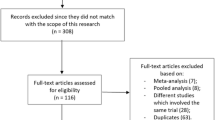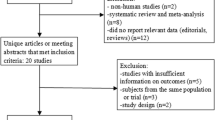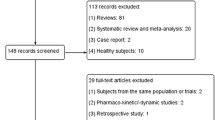Abstract
The purpose of this study is to evaluate efficacy and safety of nateglinide tablet administration in comparison with those of repaglinide tablet as control on treating type 2 diabetes mellitus in China. Pooled-analysis with analysis of covariance (ANCOVA) method was applied to assess the efficacy and safety based on original data collected from four independent randomized clinical trials with similar research protocols. However meta-analysis was applied based on the outcomes of the four studies. The results by meta-analysis were comparable to those obtained by pooled-analysis. The means of HbA1c, and fasting blood glucose in both the nateglinide and repaglinide groups were reduced significantly after 12 weeks duration but no statistical differences in reduction between the two groups. The adverse reaction rates were 9.89 and 6.51% in the nateglinide and repaglinide groups respectively, with the rate difference showing no statistical significance, and the Odds Ratio of adverse reaction rate (95% confidence interval) was 1.59 (0.99, 2.55). Both nateglinide and repaglinide administration have similarly significant effects on reducing HbA1c and FBG. However, the adverse reaction rate in the nateglinide group is higher than that in the latter using repaglinide but no statistical significance difference as revealed in the four clinical trials detailed below.


Similar content being viewed by others
References
Wild S, Roglic G, Green A et al (2004) Global prevalence of diabetes: estimates for the year 2000 and projections for 2030. Diabetes Care 27:1047–1053
Raskin P, Klaf L, McGill J et al (2003) Efficacy and safety of combination therapy repaglinide plus meformin versus nateglinide plus metformin. Diabetes Care 26:2063–2068
Kahn SE, Montgomery B, Howell WM et al (2000) Nateglinide increases first phase insulin secretion and enhances glucose clearance in type 2 diabetes. Diabetes 49:A113
Rosenstock J, Hassman DR, Madder RD et al (2004) Repaglinide versus nateglinide monotherapy a randomized, multicenter study. Diabetes Care 27:1265–1270
Karara AH, Dunning BE, McLeod JF (1999) The effect of food on the oral bioavailability and the pharmacodynamic actions of the insulinotropic agent nateglinide in healthy subjects. J Clin Pharmacol 39:172–179
Saloranta C, Guitard C, Pecher E et al (2002) Nateglinide improves early insulin secretion and controls postprandial glucose excursions in a prediabetic population. Diabetes Care 25:2141–2149
Horton ES, Clinkingbeard C, Gatlin M et al (2000) Nateglinide alone and in combination with metformin improves glycemic control by reducing mealtime glucose levels in type 2 diabetes. Diabetes Care 23:1660–1665
Keilson L, Mather S, Walter YH et al (2000) Synergistic effects of nateglinide and meal administration on insulin secretion in patients with type 2 diabetes mellitus. J Clin Endocrinol Metab 85:1081–1086
Manuel GO, Eduardo HS, Esperanza MA (2005) Effect of the administration of a single dose of nateglinide on insulin secretion at two different concentrations of glucose in healthy individuals. J Diab Comp 19:356–360
Ristic S, Collober-Maugeais C, Pecher E et al (2006) Comparison of nateglinide and gliclazide in combination with metformin, for treatment of patients with type 2 diabetes mellitus inadequately controlled on maximum doses of metformin alone. Diabet Med 23:757–762
Tian H, Li Q, Wang N et al (2004) Comparison of efficacy and safety of the generic nateglinide with repaglinide on type 2 diabetes Mellitus-Multi-Centre, Double-Blind, Dummy, Randomized Clinical Trial. Chin J Evid Based Med 4:446–452
Lindsay JR, McKillop AM, Mooney MH et al (2003) Effects nateglinide on the secretion of glycated insulin and glucose tolerance in type 2 diabetes. Diab Res Clin Pract 61:167–173
Murata C, Taniyama M, Kuriyama S et al (2004) Meta-analysis of three diabetes population studies: association of inactive ALDH2 genotype with maternal inheritance of diabetes. Diab Res Clin Pract 66:S145–S147
The Cochrane Collaboration’s Information Management System (2005) RevMan 4.2.8. Available from http://www.cc-ims.net/. RevMan. Accessed 2 November 2008
Xu D (2004) The correct use of meta-analysis. J Chin Pract Med 4:11–14
Acknowledgments
We gratefully acknowledge the editor and the reviewer whose valuable comments and helpful remarks and suggestions for this paper led to a remarkable improvement.
Author information
Authors and Affiliations
Corresponding author
Rights and permissions
About this article
Cite this article
Li, C., Xia, J., Zhang, G. et al. Nateglinide versus repaglinide for type 2 diabetes mellitus in China. Acta Diabetol 46, 325–333 (2009). https://doi.org/10.1007/s00592-008-0092-1
Received:
Accepted:
Published:
Issue Date:
DOI: https://doi.org/10.1007/s00592-008-0092-1




